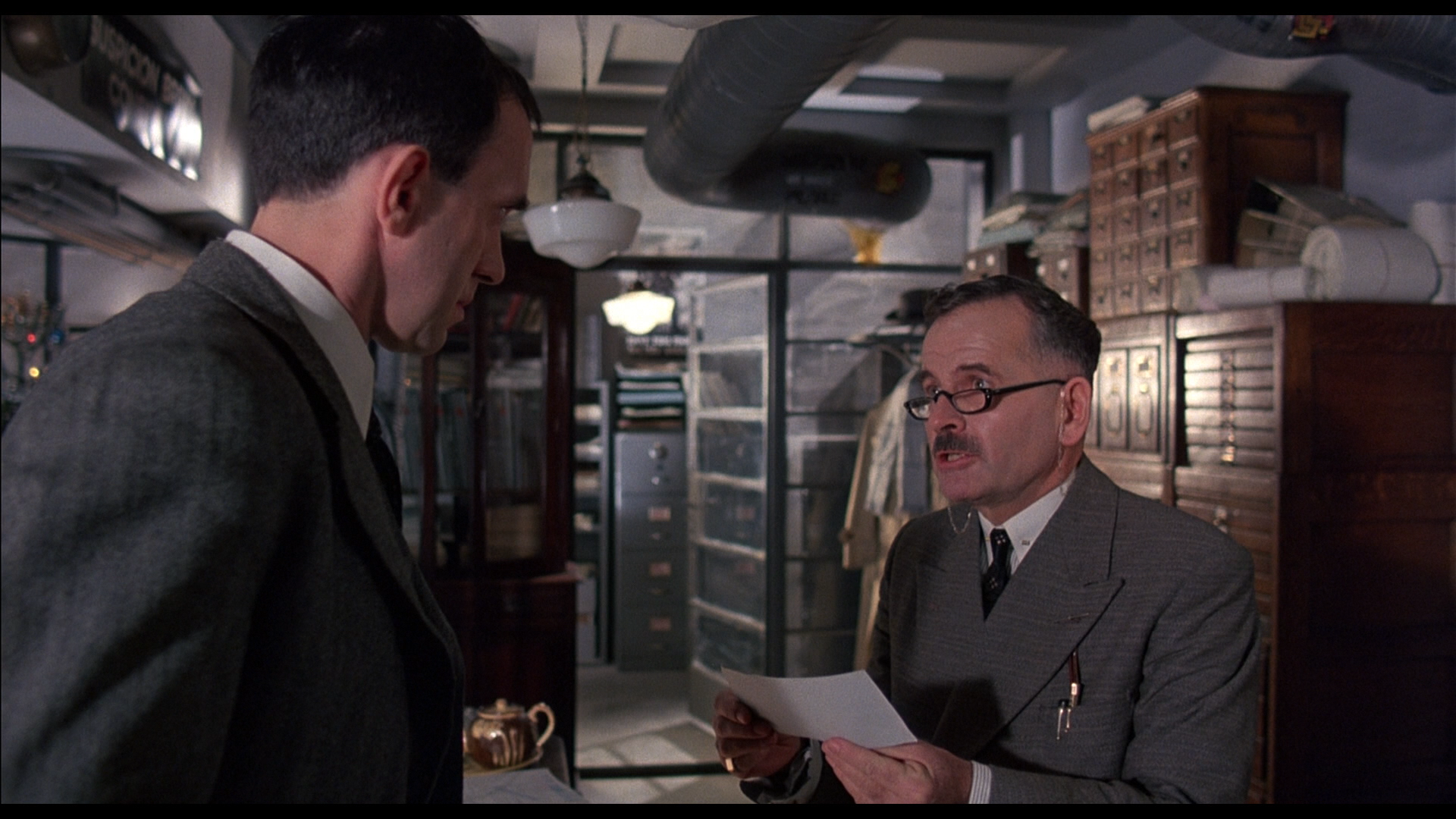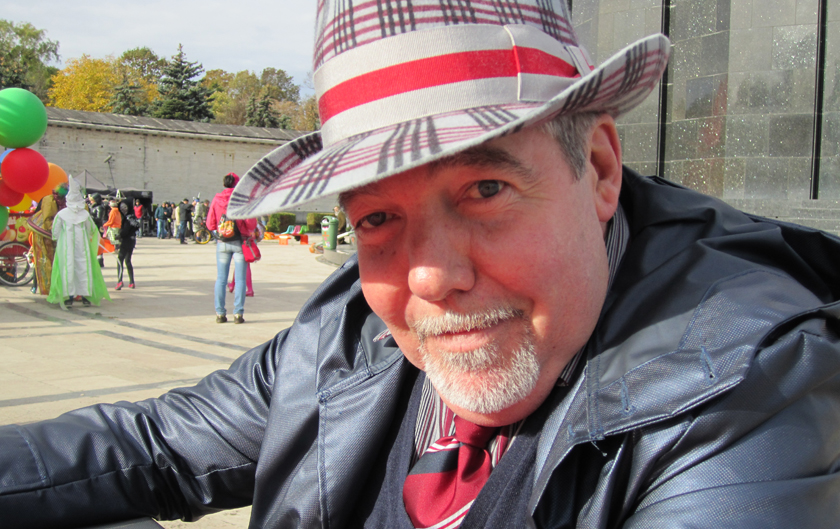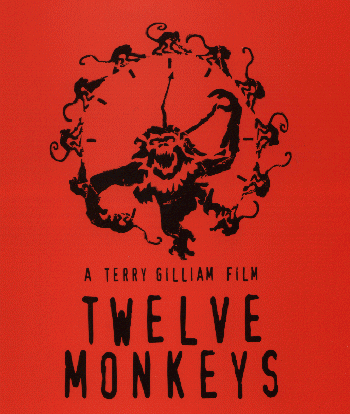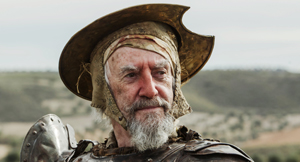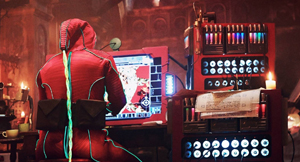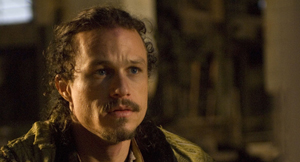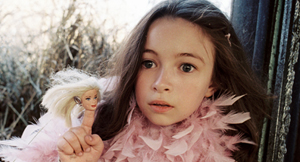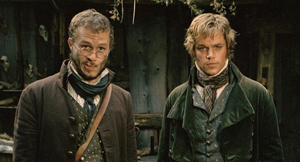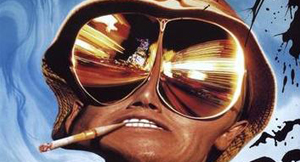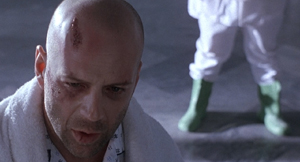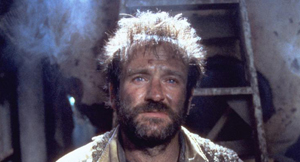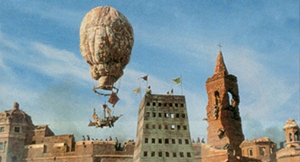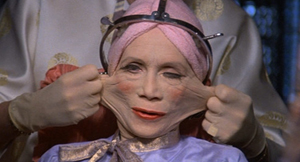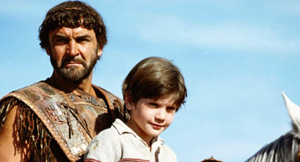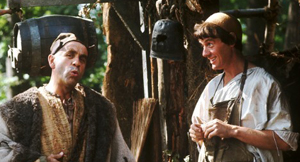Mick Audsley is the editor on The Imaginarium of Dr Parnassus, the new Terry Gilliam picture. Audsley is one of Britain’s most experienced editors, having cut a huge number of important British films. These include Stephen Frears pictures Walter, My Beautiful Laundrette, The Hit and Dirty Pretty Things. He has also edited Captain Corelli’s Mandolin for John Madden and Harry Potter and the Goblet of Fire for Mike Newell.
In 1996, Audsley edited Gilliam’s feature film 12 Monkeys, and is featured in the documentary The Hamster Factor.
Audsley spoke at length to Dreams in October 2008 about his work. For more on Audsley, click on the BFI screenonline website.
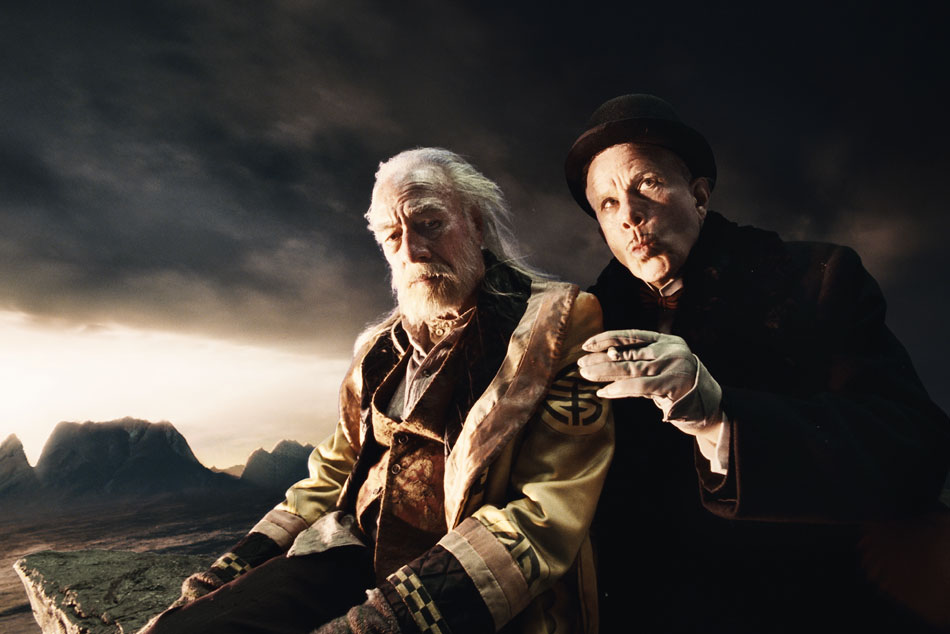 |
Christopher Plummer and Tom Waits in The Imaginarium of Dr Parnassus |
Phil Stubbs: Have you finished work on Dr Parnassus?
Mick Audsley: Well, we’ve had difficulties in the scheduling of the postproduction. My contribution usually goes right through to the end of the dub and the completion of the film. The film is basically cut, and the score has been done. I would normally be involved with the actual completion of a film on a full-time basis. Yet because of the ongoing visual effects work, if I was on full time, I would probably only be working a few hours a week. Things have got out of synch. Normally the computer generated shots are being produced within the period we are completing, and that’s got seriously delayed – so an amount of work has moved slightly outside of the normal schedule.
I’m still involved with the making of the film. In fact, Terry’s asked me to go and see it next week. I’m just not working on it full time. It’s not ideal at all, it’s rather like having one of your children leave home a couple of weeks before their 17th birthday. My contribution, the major part of what I’ve done is complete, but normally to do with the mixing and finishing the film I would be involved – but on this one I can only be there in a part time capacity.
How did you get involved with the picture?
Well, because I had done 12 Monkeys all those years ago, Terry and I have kept in touch. He offered me the job. Lesley Walker, who’s my good friend, and other fellow editor, who has worked with Terry more than I have, wasn’t available, I think. Terry said, “Wouldn’t it be lovely if you are free, have a look at it and see what you think.” It was late summer last year [2007]. I started to get involved and committed to it in October 2007.
As part of preproduction, what normally would an editor be involved with?
People I have tended to work with over these many years are people I would consider my friends, because I have been fortunate to work with people who have become my friends. I can’t remember how it went with Parnassus, to the letter, but Terry sent me a draft of the script and asked me what I thought. We talked about it on the phone, and he said, “Are you free? Maybe it’s going to happen.” I said I’d keep the time free.
I remember going down to Battersea when they were in the early stage of preproduction. We’d talk about the project and the visualization of it, and things clunked into place. As you know, this film has had a precarious financial history, so I was always concerned about the ambitions of the film against what the budget appeared to be – and this is long before Heath’s death.
In those days the challenge was just the matter of making Terry’s film within the constrictions of the money that was apparently available, so it was always a worry that we’d be able to realise the movie at the level that I felt and knew that it would need.
I popped in the office in Battersea. I saw the sketches on the wall. The word was $30m. It seemed pretty ambitious for the cash
The numbers don’t mean that much to me to be honest because it’s not my area… but I remember that sinking feeling in my stomach going down like a lift. I remember thinking: OK we’ll start and see where we get to! But it was ambitious and perfectly Terry-like.
It’s a picture that got going with faith and it has got through production with a great deal of faith
Yes, the one thing that you would say about this film, even up to the point of Heath’s absolutely tragic death was: a wing and a prayer… we’ll get through it somehow. Let’s try and go for it. And once we got to the other side of last Christmas, when the shoot was coming in, there were all kinds of time restrictions, and there were already things we were going to mop up in Canada, because of lack of time and also the weather.
Filmmaking as you know is incredibly practical and there were things we were trying to get through. We thought, “Oh well, we’ll go to the studio in Canada and we’ll be able to mop up any details that we need to get to,” to fill in for lack of time and resources in London.
Yet there was another blow in realising that it wasn’t going to be possible because of Heath’s death. I spoke to Terry that night that Heath died. We didn’t believe it, and we also had a long and serious discussion. We decided we can’t make the film, let’s stop, let’s not try and make a compromise film.
Aesthetically, we have had to reinvent the movie from the ground up. And that’s had a huge impact on everybody, particularly in editorial. That’s why I said it’s aged me, I’ve had to come to terms with the idea that we had to reinvent the film. Terry and I had a very long discussion about whether the best option was to cut loose, because we didn’t want to make a compromise film, because it’s not in our nature to do that.
I’m unclear about that very weird week that followed Heath’s death. Slowly, Terry was in Canada, and I was here, we were put in the cutting room at the insurer’s expense to conceive of a possibility of being able to make a film (not the same film) with what we’ve got and a re-conception of the writing of the movie and initially perhaps one other character to play Heath’s part and then as it turns out three other actors playing the one identity. Whether we have pulled it off I’m not entirely sure, but we’ll see when we release it on un-jaundiced cinema goers. It is an extraordinary situation.
We in the cutting room are the midwives to the writing process. And because Terry’s such a generous person, we are involved in the discussions and all the conversations about that. In the event of what happened after Heath’s death, which was a bomb drops on the movie’s future, we were all very involved in what we could do once we had made the decision to go on and make the film, which in my mind was a difficult one because I didn’t want to compromise the film.
We realised we would be making something else and moreover we didn’t know what that would mean. Perhaps even to this day we are not quite sure what the impact of that decision to have multiple actors playing one character really means in the audience’s mind. The personality and embodiment of an actor, a personality like Heath who was much loved…
The ability of the audience to suspend their disbelief and be carried along by the story
Yes, it’s the reality of what’s happened, the fact that they have seen somebody that they know is giving their last performance. Does that affect their perception of the movie?
Yet what he did was absolutely wonderful. It was incredibly positive, you couldn’t get better work. I can’t say that more vociferously. He was positive, enthusiastic and inventive, he was just a joy. I didn’t believe the news of his death, because he was somebody who seemed to be so in control of his craft, his art and everything at that particular moment in time. There was no hint of all the things that we understand were part of that ghastly demise, so if he was only sleeping two or three hours per night which is what we believe, and that he was exhausted, there was no evidence of that in any way. I can tell you as an editor, I know about that stuff when people are fluffing lines and have not prepared.
Heath was so prepared and so positive, and was helping by doing menial jobs to get the film shot. He was committed 150% or more to make Terry’s film, so that’s why I did not believe it that night, and just couldn’t get my head round it. So I am sure it was just misadventure in some ghastly way which we will be forever upset about.
But it will be a major, major issue to do with the spine of the film which has been chopped up into different performances and although there’s a conceit in the movie to do with changes behind the mirror, in an Orphee / Alice in Wonderland / down-the-rabbit-hole kind of genre, who knows what that would really mean because the audience has a relationship with film stars not just the character. It’s a relationship with not only Tony Shepherd who he plays, but also Heath, who then becomes Johnny or then becomes Jude Law or Colin Farrell. I don’t know what that really means. I’ve seen Shakespeare with a lot of swapping characters out and people playing different parts – it is a theatre convention. It is less common in movies. In That Obscure Object of Desire – Bunuel did it miraculously well. I don’t know what it means in the current temperature of people going to the cinema.
Bunuel handled it brilliantly. To this day I remember sitting in what was the Academy Cinema in Oxford Street having watched the film, having been absolutely blown away by it. A couple who had been sitting in front of me, the guy said to his girlfriend, “Wasn’t that wonderful, how brave to pull off that switch of actors for one character.” His partner said, “Did they do that?” It had worked, she hadn’t twigged even though they looked completely unalike.
So we don’t know. I may slip on a banana skin later, but Terry and I worried about that until we were demented. But actually in the screenings of the film that we’ve done so far for friends, that seemed to be OK. People were making that transition more fluidly than we had hoped for. I may be proved wrong later, but that’s how we’ve been feeling in the last few months.
(Continued below)
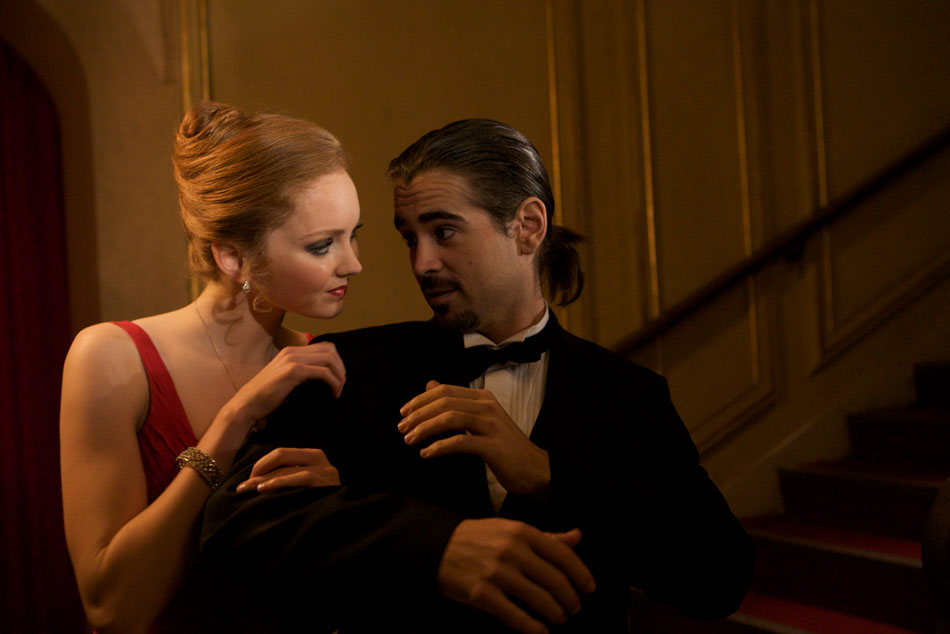 |
Lily Cole and Colin Farrell in The Imaginarium of Dr Parnassus |
Could you describe the editing process and the equipment and software you have used on the picture?
It’s common practice on a picture of this stature and size that the editing team is employed from the first day of photography. We receive all the material. There were three of us, an editor and two assistants. We received all the material on a daily basis, and as quickly as we received it, I would start to sketch out a cut of each scene that came in. The objective is that by the end of shooting, within a week or ten days, I have a cut of the movie. This is normal practice. I am putting aside the issue of Heath’s death because that’s an abnormality, but certainly by the time Heath died we had pretty much everything cut that was shot in London.
We used the Avid editing system to work with – it’s become an industry standard.
Once processed, the film negative is digitised. We receive them as either tapes or files and they are inputted into the digital domain. In this case it was our first go at high definition material, which looked great. And we cut that and when the film is completely finished, we return to the negative and do what’s called the DI [Digital Intermediate] to scan and input it into the digital domain direct from those original pieces of negative for the best quality.
Terry is respectful and enthusiastic about what I’ve put together, because we know each other very well. As we go along we discuss everything in detail whenever we can, and we show stuff all the time. I build the film on a day-by-day basis and the only oddity in this case was that there was a lot of bluescreen visual effects work to be done.
There’s a normal period at the end of shooting, say two or three weeks after, where we screen the movie and then ask ourselves… where do we go from here? But in this case, Terry and I both decided that there was so much visual information missing which was going to be built in the CGI world, that we would delay that. We just felt there wasn’t going to be enough information to really make our normal appraisal. So we actually worked for another six weeks together, his director’s cut period, without having people watch it, because we felt that people against bluescreen was not going to inform us. We had to develop the images more. That was quite unusual.
What problems are caused by editing sequences with substantial bluescreen?
It’s a nightmare from an editorial point of view. The job we do is to evaluate the image in relation to the construction of the movie and how it needs to move forward. You are a conductor to the orchestra of information. You need to say this needs to go slowly because you need information to take it in. Or you say this needs to go quickly. You are making all kinds of judgement to do with perception and timing and the information of storytelling that comes across to the audience. So if fifty or seventy percent of the screen you are orchestrating has not been manufactured, the evaluation of that quantity is extremely difficulty to assess in its rudimentary form.
So you have to make a guess. Then middle stage artwork – unsophisticated imagery – are applied to the missing part of the image and then we have to make adjustments once they start to progress.
So you say there is going to be a river there, but I don’t know what that river looks like or feels like, and somebody interacts with something you can’t see. So generally the great mistake of film editors of which I count myself a fully paid-up member, having made this mistake and have done again, is that you never quite give enough time to the elements which are already set which you have to turn over, you have to commit, to pick and guess what’s there and then they apply the images to them. So it’s rather like cutting up bits of wallpaper for a room which you haven’t constructed the dimensions of. And when you get into the room and see the bits of wallpaper that you have planned, they may not fit the dimensions of the space, and adjustments have to be made. Fortunately, we seem to be doing pretty well, we are talking about adjustments of a few frames here and there once the effects come in.
That’s generally the problem: you underestimate. So in other words if you’ve got a figure, an actor in front of a background, which doesn’t exist, you’ve got to choose his performance for its value, and you want to make that work but you don’t know what the background is, and sometimes the background can affect your perception of the value that you need, with the foreground. It’s very tricky, and it drives you slightly bonkers.
How are the effects applied?
In the case of Terry’s film they are generally not interactive things for example something you can’t see like an animal or a figment of the imagination. Generally in this case most are imagined places, imaginary worlds, which are extraordinary and Terry-like, and wonderful. The degree with which you need to understand what that actually means is still being developed as we speak now. So, often it is very hard to imagine the value, you have to close your eyes and work out the timings of those things.
How is editing with Terry different from other directors?
The great thing about working with Terry is that he is a person who is able to do all the jobs involved in filmmaking as well or better than any of us who have the good fortune to be there. At the same time, because he is a human being and generous, he also will feel the need to have other personalities to adjudicate and contribute.
He’s very generous about the contributions. In fact, I always feel very free to do my thing, and have it ticked off and approved. But at the same time I know he is perfectly capable of doing it himself. Some people see that as something to be wary of, but in my case it gives me great pleasure – because he also appreciates so greatly all the craftsmanship. He would just let me run with it, and then say, “Have you thought of that?” It’s like a conversation – where you spark off each other and go up on your own capability as an individual. That’s really the fun of it – you run with it for a bit, I’ll run with it for a bit and we’ll get somewhere special – that was certainly the case with 12 Monkeys, the finished film which I adored, and had a great time with him. I think that’s true on this one too… the only difference in this case is we both had all these extraordinary criteria and financial criteria to deal with in that process.
It’s a lot of fun because his ability to do all those jobs also means he absolutely gets it when I say, “Can I go away and do something and show it to you?” He gets a real kick out of seeing it. That’s really satisfying, immensely pleasurable and a lot of fun.
Does the way that Terry shoots in terms of wide angles and camera placement…
He uses lenses brilliantly. His understanding of film language is unsurpassed. It is always interesting, and I could analyse and tell you at length, to disseminate the psychology of what he chooses. His eye is so acute and sharp that that makes that process very good fun.
… yet does the way he shoots create any specific problems in editing – in trying to get one shot to associate with what follows?
No, no, no, quite the opposite I’d say. If ever we had those problems it was to do with just not having the time. In the case of Parnassus, it was to do needing to get the other angle, but running out of time, and figuring out ways of dealing with that. Certainly his design is absolutely impeccable, because he understands exactly what we need in the cutting room to make it work, or he would come and say, “Look we didn’t get that, how do we figure out a way to get round it?” Filmmaking is immensely practical.
Do you and Terry have any disagreements?
There is a different sensibility in the editing process if the director is also the author, auteur or writer. Perhaps one has to take on board the lucidity which that brings, but also the auteur needs an editorial mind to adjudicate that to a degree. I’m very frank with Terry in saying for example, something should be shorter, or we should make it clearer. Because one is dealing with script-editing and writing rather than the directorial manufacture of the piece.
It was different on 12 Monkeys because it was David and Janet Peoples who wrote that – we were all hired hands for that piece of writing.
I have to put on a slightly different hat which is to say: let’s really confront the writing here. But he’s very good because in this case there was an issue with a scene which written on the page I had doubts about. And when I saw it shot I thought that it wasn’t going to work. I would pull his leg about it. I’d say, “It’s gotta go Terry, it’s going to be out of the movie.” And it was, and he did, and he was gracious about that.
So I’m attacking the writing as much as the manufacturing at that point. But he is good about that and very quick to respond. So perhaps you have to, as an editor, consider the fact that they are involved as a writer as well as a director. Then the language that you use to put your viewpoint across is articulated with a slightly different sensibility.
If it’s a director who deals with somebody else’s writing, that’s just a slightly different dynamic. We don’t have disagreements about that, not at all. I think we’re both very happy about the film. I think probably there’s always a desire to make a film slightly shorter. But because of the nature of this film and all that’s happened to us, we haven’t exposed it to the audience which would normally tell us whether it is playing well, because we actually haven’t manufactured it completely yet because of all the computer generated imagery.
What was the duration of the first cut and what needed fixing?
I think it was something like a 2 hr 15 movie, so 135 at the first cut. We’re now a film that is 114, just under 2 hours, which is where I want to be. Although I have a sneaking suspicion that there is one minute or two minutes which should come out. Terry and I have talked about it. But we are waiting until we have all the computer stuff in, and then if we feel as though there is something that is not playing, we’ll look at that.
It’s always my intention to make a lean first cut, because I personally haven’t got the ability to look at 3, 4, or 5 hours of film edited. I just want to get it quite a long way quite quickly so we can say we’re in the right ballpark. Terry will say: if you’re uncertain about something, take it out, because we can always put it back.
Even when he was shooting the film, we decided to see it as a slightly fat film and then put it on a small diet rather than a long extended WeightWatchers course for months on end. But I was never too worried about the length of this film. We knew we’d be under two hours by the time we had examined it.
What have you found the most rewarding about this picture?
We have been thrown into the most extraordinary narrative convolution with poor Heath’s death. I think we have articulated a film in spite of that, and whatever the public make of it, I am very proud of that fact that we have done that. Also from the point of view of insurance, we have made a film very economically, and it seems to me that we should be rewarded for that, rather than being punished, which has been the case, with having to prove why we made certain decisions to get it finished and kind of wriggle out of the most extraordinary circumstances.
Now to 12 Monkeys… do you think the film is better with the scene with the scientist on the aeroplane at the end, or is it a better film without it?
We had endless discussions about that. I can’t quite remember, but I think I was of the camp at that time to leave the scene out… David and Jan Peoples had sent me that script long before Terry was involved, I had worked with them many years before, so I knew about the film and was desperate to make it. I wanted to do that film very much. And it was a thrill that it went to Terry, and that he asked me to do it. That was just perfect.
I think we previewed the film with and without that last scene. And to the audience at the time, it didn’t really make a huge difference in our perception of their digestion and rounding out of the movie. At the same time I enjoyed the conceit of it a great deal. So I’m completely on the fence about that one. I had great convictions all those years ago, but now I’m unable to come down one way or the other. We did put it in at the end as I recollect, and I think in a way that was the right choice, so I have no regrets.
The day after Heath died, my assistants – bless them – hid the tapes, we hid all the material, we were terrified anyone would get hold of it all. We didn’t know if we were going to be able to finish the film. We literally hid them under the sofa in the cutting room. We also took tapes home and hard drives and hid them in various cupboards, we didn’t quite know what it all meant in our naive way.
I was naive as well because – my youngest daughter is seventeen – I had no real understanding of what Heath meant to that age group, obviously exposed to his death. Suddenly it was so much bigger than I had ever imagined. Perhaps I had been naive about that status, from my rather middle aged viewpoint. But the main thing now is the film is alive and well and will get finished in spite of all the difficulties we have had. It will be a great thing to get through, and get it out as Terry intended it. It certainly deserves it.


